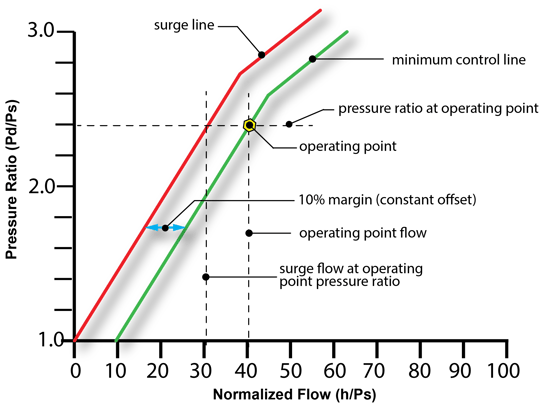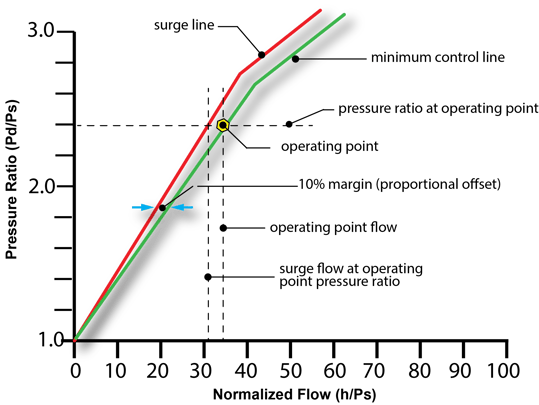With the proliferation of dedicated digital anti-surge control systems over the last 20
years, there has been an associated proliferation of promises and myths about the
surge margin. In this post we'll try to explain the need and use of the surge margin.
What is surge margin?
The simplest definition of surge margin is the distance of the operating point from the
surge line. This definition requires some additional qualifiers in order to make it useful
as a comparison criterion for the control system performance. The compressor
performance map is commonly used for defining the performance of a compressor
section (or stage). The performance map is a useful device for relating the anti-surge
system performance to the compressor operation.
How is the margin calculated?
The surge margin is calculated by dividing the distance of operating point from the
surge line at the same pressure ratio by the total flow scale. The minimum control line is
based on the same technique. Therefore, if the minimum control line is set at 10%, when
the operating point is on the control line, the operating point is 10% away from surge line
(on a constant pressure ratio basis) as compared to the full range of the flow scale. If the surge
flow at this pressure ratio is 30%, for example, then the surge margin relative to the compressor
surge flow is 10% / 30% = 33%.
The standard technique used by Tri-Sen for establishing the minimum control line is to
use a constant offset. A proportional offset can be used as well that has the effect of
changing the surge margin as a function of the full scale of the flow term to a function of
the surge line flow. The proportional approach is appropriate for use on in applications
that have a widely varying molecular weight. Whether or not to use this technique
should be decided during the execution of the control projects.
These graphics show the two methods available for determining minimum surge margin.

technique that applies a constant margin, relative to the total flow scale. In this example,
the surge margin of the upper graphic would be 33% of the surge point flow (10% divided
by 30%, the surge point flow).
The lower graph incorporates a proportional offset for the surge margin. The lower graph is
equivalent to setting the surge control line on the basis of the surge flow (a 10% surge margin
is 10% of the surge flow at the operating point pressure ratio).

How much margin is appropriate?
Regardless of the technique used to measure the margin (constant margin or
proportional margin), the amount of margin required for a particular installation depends
on a number of factors. The amount of margin required to protect the compressor is not
necessarily the same as the amount of margin required to protect the process. A simple
analogy is highway traffic. How closely can you follow the car in front? The more
distance you leave between you and the car in front, the more time you have to react
and the less abruptly you will need to react. But in heavy traffic, it you leave too much
room, other cars will cut in front of you. You have to make the decision based on
several factors.
In a compressor installation, the most significant parameter that will affect the
appropriate margin is the sizing and reaction time of the anti-surge valve. If the valve is
inadequately sized or opens too slowly, a wider margin will be required to prevent
surge. Even if the valve is adequately sized, the impact on the process needs to be
considered. If the minimum margin is small, the valve will have to open more abruptly to
prevent surge, upsetting the process.
For processes that routinely operate near the minimum control line, a wider margin will
tend to waste power. The process dynamics as dictated by piping lengths, valve
locations, vessel and piping volumes and mechanical equipment is a big influence on
the required margin that must be considered.
How is the minimum margin determined?
Traditionally, trial and error was the most common technique for finding the required
margin. For installations that routinely operate far away from surge, a conservative
margin is chosen (10% of the full flow scale). The only time the anti-surge controller is
active is during startups, shutdowns and significant load drops. But compressors that
routinely operate near the minimum control line will benefit from a tighter margin, if the
system can tolerate it. In the past, about the only way to evaluate the minimum margin
requirement was to test the control system on the live process. Over time, if the
protection proved to be inadequate or if the process disruptions were too severe, the
margin would be increased.
In the last few years, the availability of rigorous, high fidelity dynamic simulation
software has allowed anti-surge control system designers to evaluate the dynamics
of the system and test the control system performance before the control system is
even installed. This software can be connected directly to the project control system
software, allowing the actual project software to be tested rather than just a simulation
of the control software.
Other influences on margin selection
A good anti-surge control system does not rely just on the controller margin to protect
the compressor and the process. Other features that need to be included are
performance controller decoupling, adaptive tuning, load loss anticipation and open loop
response. And of course the experience and qualification of the engineering staff that
applies the control system is the most important feature that should be evaluated when
selecting a compressor control system supplier

